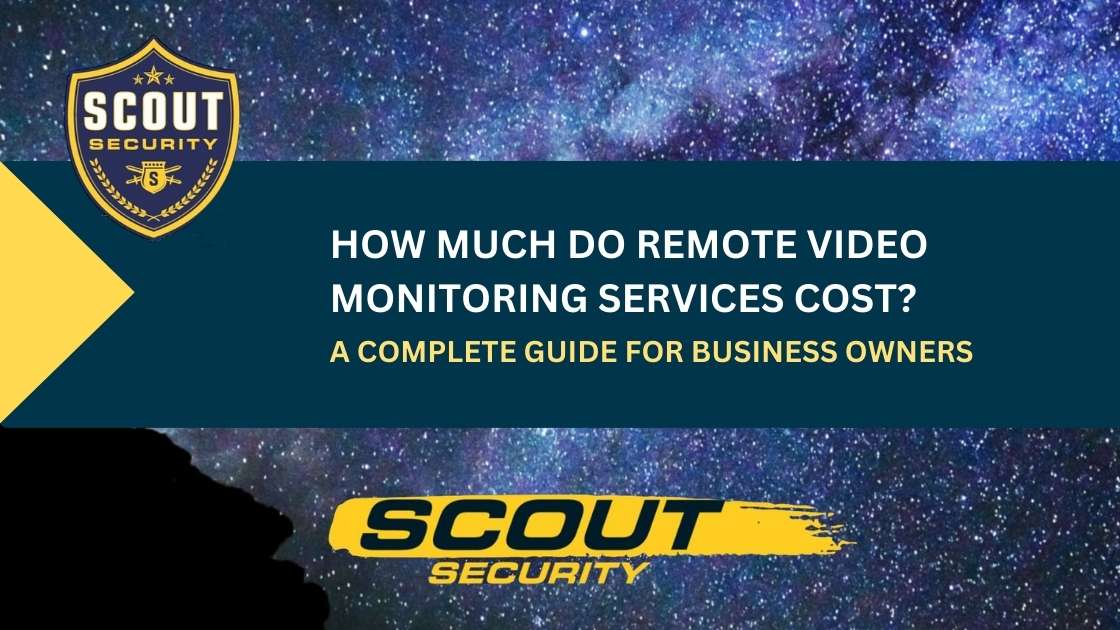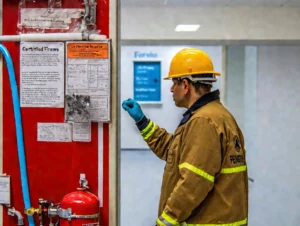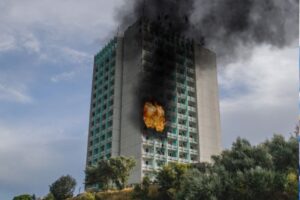The cost of remote video monitoring services will vary widely depending on your business’s security needs. But, it can range from a few hundred (for home security systems) to a few thousand dollars per month for commercial systems.
For small businesses, it can range from $3,000 to $7,000+ and up to $15,000+ for enterprise-level systems.
Factors affecting CCTV monitoring costs include the following:
- Number, type, and features of the cameras
- Size, layout, and type of your business
- Monitoring hours
- Monthly activity level
- Additional technology
- Integration with other systems
- Other service agreements
To give you an overview, below is the estimated average cost breakdown of live CCTV monitoring services:
- Installation Cost: $100 to $2,500+ and up to $10,000+
- Equipment Cost: Depends on the equipment specifications and coverage area
- Monitoring Cost: $30 to $150+ per camera monthly or $8 to $10+ per hour
Work with Scout Security to get comprehensive remote video monitoring solutions tailored to your industry’s needs and budget. We serve businesses and property owners in the Colorado Springs and Denver Metro areas. Contact us now!
Overview: Understanding Remote Video Monitoring Services
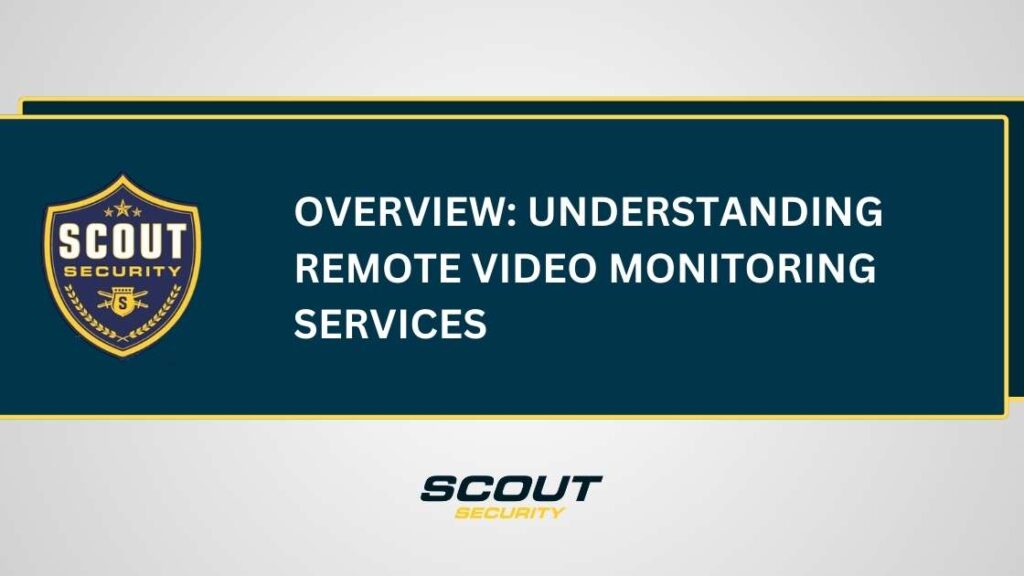
Advanced remote video monitoring services use internet-based cameras (IP cameras) to stream live surveillance footage from a remote location to safeguard properties and assets.
These cameras can be enhanced by artificial intelligence and integrated with other security systems which allows them to:
- Detect movement even in low-light conditions
- Distinguish between genuine and false alarms
- Be solar-powered for cheaper installation outdoors
- Be capable of triggering audible or visual alarms when intruders enter your premises
Pairing these smart cameras with remote monitoring services gives you both technological sophistication and human surveillance. Thus, creating a robust and cost-effective security solution.
Moreover, remote monitoring is conducted by professional CCTV operators in a central monitoring station where they observe your property around the clock to identify early signs of security breaches. This prevents crimes on your premises proactively and makes rapid response to incidents possible to mitigate damages and liabilities.
Also Read: What Is CCTV Monitoring and How Does It Work?
11 Factors Affecting Remote Video Monitoring Service Costs
The price of commercial security camera systems and professional video monitoring services depends on various factors. In general, you can save money if you install more cameras which is more cost-effective for big projects.
You need to make your security needs clear so you can choose only the necessary features to help keep costs under control.
It’s important to find a good balance between quality and price to make sure you have enough coverage without spending too much.
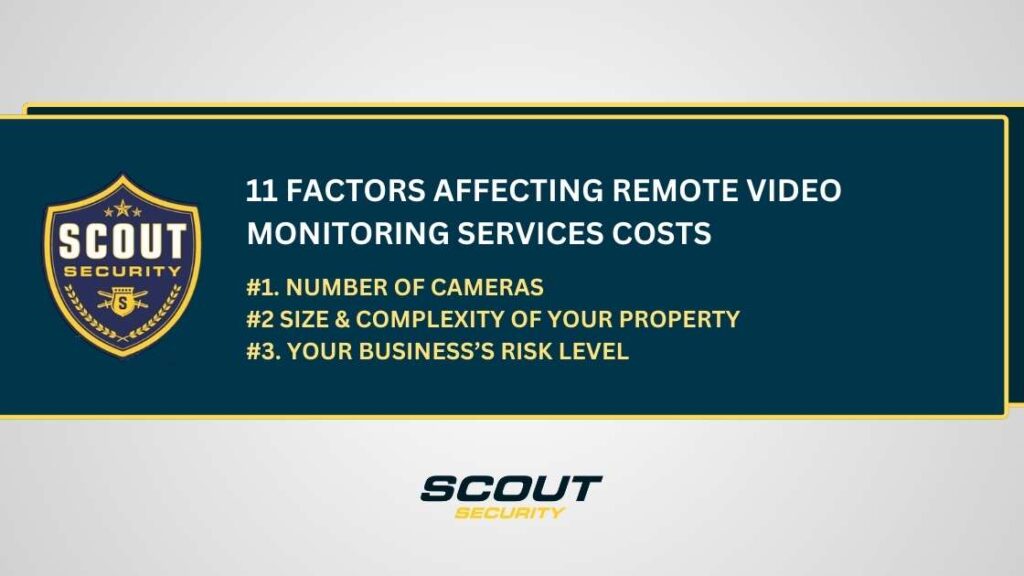
#1. Number of Cameras
The total cost of remote video monitoring services is significantly influenced by the number of cameras you need. This is because it will determine how much you will spend to connect and monitor these cameras.
Businesses typically use 10 or more cameras. Areas with many access points and high-risk spots need more cameras which will raise the cost.
Strategic placement of cameras is crucial to save on costs. Ideal installation spots include entry points, high-traffic areas, blind spots, and locations of valuable assets.
#2 Size and Complexity of Your Property
Live video monitoring service rates will increase with the size and complexity of your property.
Larger areas need more cameras and advanced equipment to ensure comprehensive coverage. Properties with complex layouts may also need additional monitoring stations and sophisticated analytics which will add to the costs.
Also Read: 15 Tips & Best Practices for Securing Your Commercial Property
#3. Your Business’s Risk Level
Properties considered high-risk, such as banks and government buildings, and those located in areas with high crime rates often need more complex monitoring systems and more frequent surveillance which leads to higher costs.
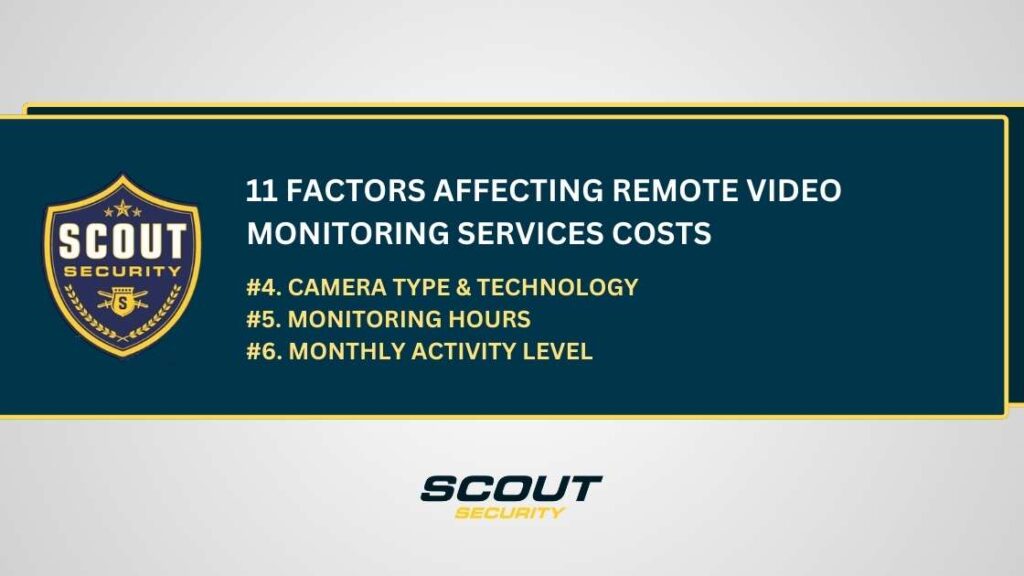
#4. Camera Type and Technology
The type and technology of cameras used will also impact the total cost of video monitoring services. It is important that you carefully assess the features that you really need to optimize your investment.
Cameras with higher video quality, wider viewing angle, better low-light performance, weather resistance, and other advanced features are more expensive.
Key factors affecting the pricing of CCTV cameras include:
- Camera Quality: High-resolution cameras, like 4K ultra HD cameras, are pricier compared to standard 1080p or 720p models.
- LensType: There are different types of lenses (e.g. fixed, varifocal, wide-angle, zoom) and camera shapes (bullet vs. dome) that have different prices based on the required viewing angle and durability.
- Vision Types: Advanced night vision modes (e.g. thermal, color, and starlight night vision) are more expensive than standard black-and-white infrared night vision.
- Weather Resistance: Weatherproof and vandal-resistant cameras are pricier due to their durability.
- Analytic Capabilities: Cameras equipped with advanced video analytics, including facial recognition and object tracking, come with higher prices.
- Other Sophisticated Technology: Pan-tilt-zoom features, two-way audio, app integration for mobile notifications and live viewing, and other technology using artificial intelligence (AI) to enhance live video surveillance will also impact the cost.
Also Read: Security 101: Types of Commercial Security Systems & How to Choose
#5. Monitoring Hours
The required duration and frequency of the video monitoring service are other factors affecting the provider’s rates. For instance, 24-hour CCTV monitoring costs more, but this will offer real-time incident responses to potential threats.
#6. Monthly Activity Level
The activity level on your premises is often determined by the number of alerts detected by AI.
For instance, areas with minimal activity will cost less to monitor per camera. On the other hand, hourly rates for high-traffic locations like parking lots will be more expensive. This pricing model maximizes your investment returns because you will only pay for the services you need and use.
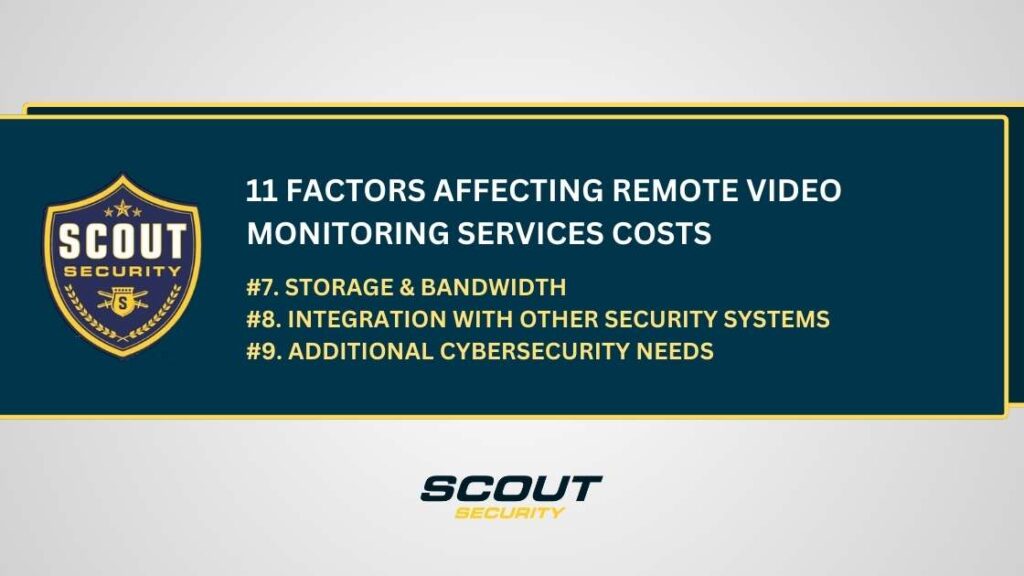
#7. Storage and Bandwidth
Storage requirements for live CCTV monitoring are influenced by the retention duration, camera quality, and the total number of cameras used.
These factors determine the necessary capacity on cloud or local servers which directly affect the total cost. Furthermore, bandwidth needs increase with higher storage demands and can potentially increase your expenses further.
How you will use the video footage will also impact the cost.
Basic setups that only store footage are cheaper compared to systems that offer remote access or third-party monitoring because they require additional equipment and more maintenance.
Also Read: Inventory Shrinkage: Causes and Ways to Prevent It in Retail Settings and Warehouses
#8. Integration With Other Security Systems
Integrating CCTV systems with your existing security systems like alarm or access control systems can influence live video monitoring costs. Additional custom features like tailored analytics or reporting can further add to the price.
#9. Additional Cybersecurity Needs
Using IP-based CCTV systems will require robust cybersecurity measures to protect your data from hackers and malware.
These cybersecurity measures may include the following:
- Strong password policies
- VLAN segmentation
- Regular firmware updates
- Opting for isolated networks to mitigate risks associated with internet connectivity
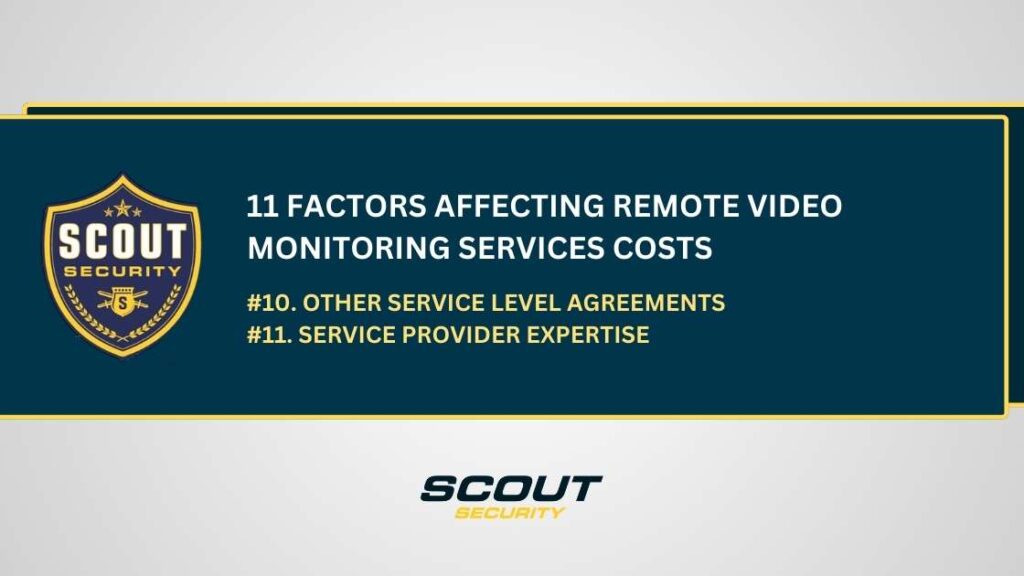
#10. Other Service Level Agreements
Aside from the ones we already mentioned, you will need to pay more for higher service levels due to the additional resources and technology required to support them. As we’ve said, basic services that only record video are less costly compared to services that include live video monitoring and active response.
NOTE: Remote video monitoring service providers will often offer different cost models.
Remote CCTV monitoring service providers will have various pricing models to accommodate your diverse needs and budgets.
Options may range from basic monthly subscriptions starting at lower rates and scaling up to premium monthly rates. Alternatively, cost-per-event plans are also available where the provider will charge more for the first events and less for subsequent ones. This model suits properties with low activity levels.
5 Types of Remote Video Monitoring Services
In addition, below are just some of the remote CCTV monitoring services that private security firms might offer you that can add to the cost:
- Live Video Monitoring
Live video monitoring offers real-time surveillance of your property by trained professionals using advanced cameras. In the event of an alarm, they promptly review the footage to address potential security threats and contact the authorities if needed.
This service is particularly beneficial for high-risk businesses requiring quick responses to security incidents, though it tends to be more costly due to its immediate and proactive nature.
- Video Analytics
Video analytics involves extracting useful information from digital video by automatically analyzing live video footage to identify, track, and classify various elements such as people, vehicles, and other objects. It is used to recognize patterns and detect unusual activities for proactive threat prevention.
- Integrated Video Monitoring
This service integrates video surveillance with other security systems like access control and alarms to create a robust security solution for businesses seeking comprehensive protection.
With this strategy, situational awareness is enhanced by combining traditional alarm signals with real-time video feeds for precise verification of alarms. Thus, minimizing false alarms (e.g. alarms triggered by an animal or leaves). This will also prevent wasting your resources in case of false alarm activations.
- Mobile Video Monitoring
If you want to be able to watch live video feeds of your property remotely using your tablet or smartphone, you might want to include this service.
- Cloud-Based Video Monitoring
Cloud-based video monitoring services allow you to securely store substantial video footage on cloud servers over long durations. This eliminates the need for additional hardware and allows for immediate deployment and ease of scalability.
Also Read: 5 Major Differences Between Monitored vs. Unmonitored Security Systems
#11. Service Provider Expertise
Lastly, providers with extensive experience and a solid track record often demand higher prices due to their dependable service and advanced technological capabilities.
These companies, including Scout Security, have the required licenses and certifications, are fully insured, and often hire former law enforcement officers and veterans who already have the experience needed to deal with various security challenges.
Estimated Average Cost of Remote Video Monitoring Services
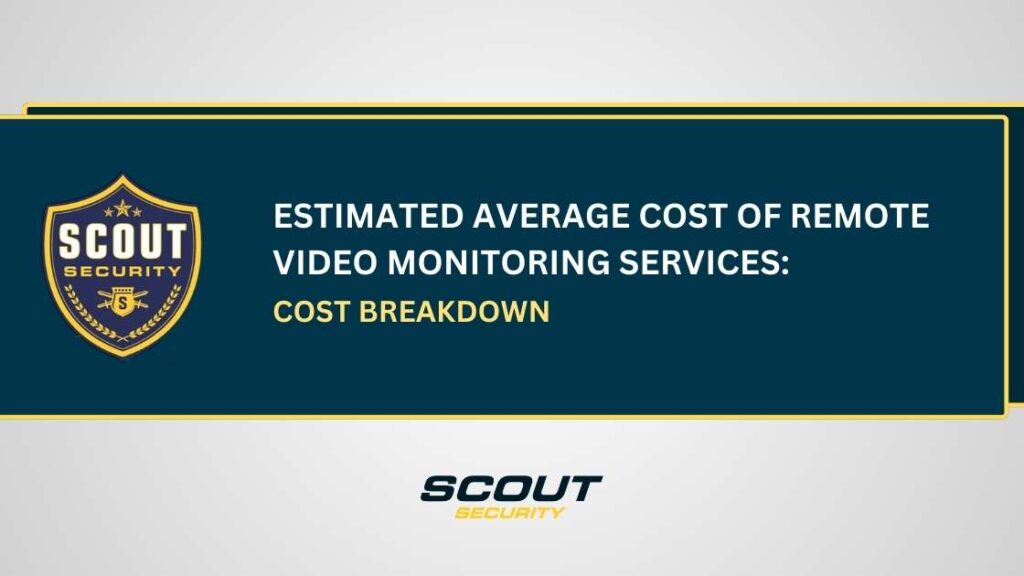
Services are priced variably, allowing you to select plans that align with your budget and specific security requirements.
As you’ve learned from the previous sections, the cost of remote CCTV monitoring services will depend on the complexity of the surveillance system, the type of services you choose, and the service provider.
But compared to hiring onsite security personnel, remote monitoring is generally more cost-effective for small and low-risk businesses, even with integration with advanced AI camera technology.
For instance, the cost of a commercial system with cloud storage for a small business may range from $3,000 to $7,000. On the other hand, an enterprise-level system with around 50 cameras can exceed $15,000.
Live Remote Video Surveillance Cost Breakdown: Installation, Equipment, & Monthly Monitoring Fees
Live remote video surveillance systems usually involve three primary expenses: installation fees, equipment costs, and ongoing monitoring charges.
The installation fee covers the initial setup of the system. Equipment costs vary depending on the technology and features required. Finally, you also need to consider regular monitoring fees which may be billed monthly or annually.
#1. Cost of Installing Video Surveillance Systems
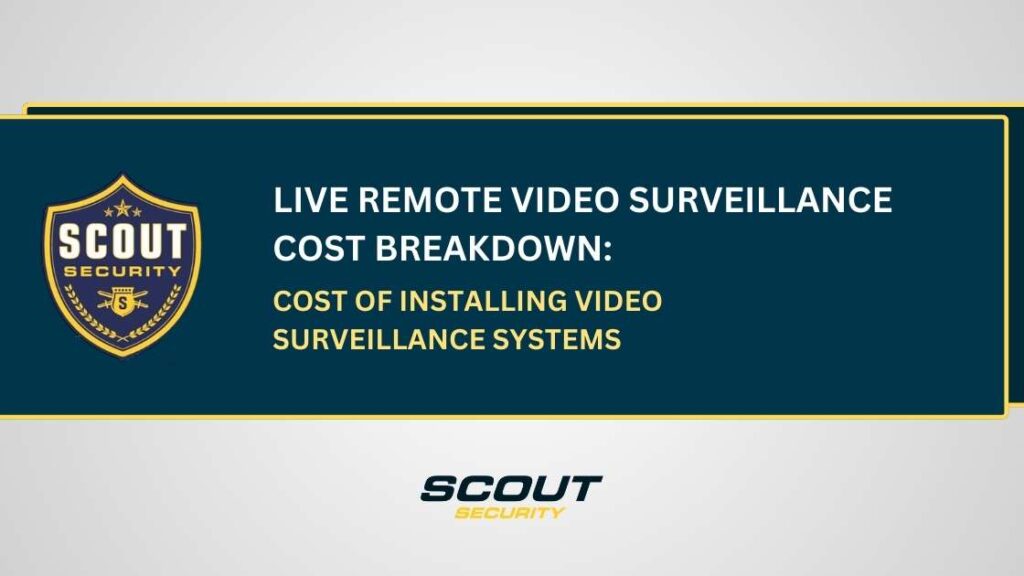
The installation cost of your CCTV system will depend on the number of cameras you need along with the features that will influence the complexity of the system. Some may charge you an hourly rate.
Installing video surveillance typically involves a one-time fee covering camera setup, network configuration, and integration with a monitoring service. This fee might also include the activation of services when applicable.
Here are estimates for the installation cost of commercial CCTV systems:
- Basic systems for small to medium facilities generally range from $100 to $2,500+.
- Larger facilities (e.g. warehouses and other industrial sites) that need advanced and feature-rich systems might spend up to $10,000+.
Though more expensive, professional installation guarantees reliability and correct implementation. DIY options, while cheaper, pose risks related to improper setup.
Hiring a professional company offers the benefits of experienced technicians who are trained to install video monitoring systems efficiently and effectively. It ensures optimal system setup and coverage. Thus, minimizing disruption to your home or business.
Also Read: Warehouse Theft Prevention: 19 Best Surveillance Practices
#2. Equipment and Hardware Costs
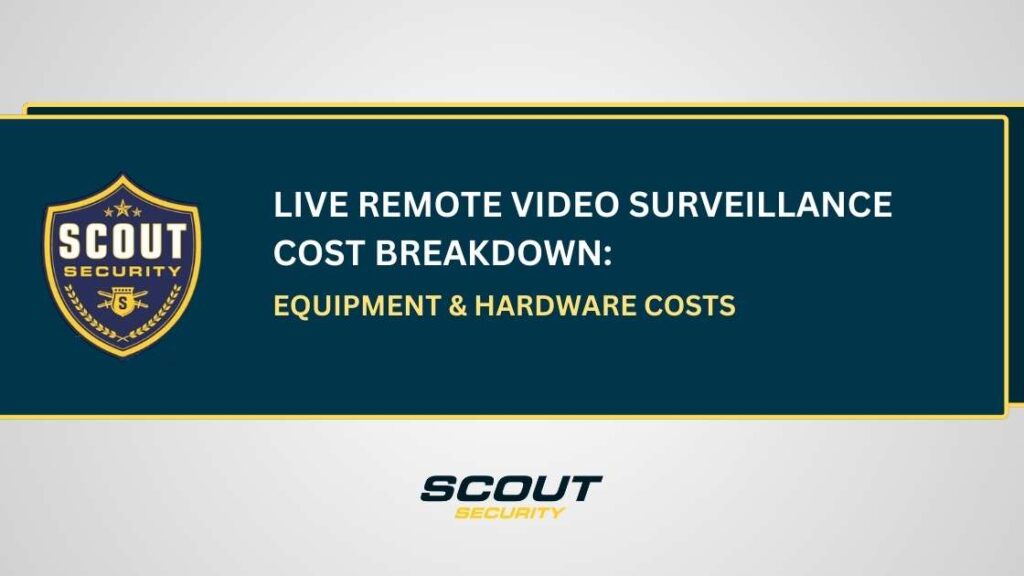
Of course, you will need to purchase the necessary equipment for your video surveillance system. This will take up the bulk of the total costs and includes cameras, NVRs, DVRs, and other additional components required for complex surveillance setups.
Camera Costs
Security camera costs are influenced by factors such as resolution, special features, and durability.
- Basic Indoor Models: $50 to $150+ per unit (offer standard video quality without extra functionalities)
- Outdoor Cameras: $100 to $500+ per unit (weather-resistant and may include features like 720p or 1080p HD video, night vision, and motion detection)
- Advanced cameras: $300 to over $1,500 per unit (equipped with 4K ultra HD resolution, wide-angle viewing, and video analytics)
Video Recorder Costs
Video recorders save footage and allow you to manage recording and playback. The cost will depend on the device’s capacity and features.
- Entry-level DVR systems start at $200+ and are suitable for small setups.
- Mid-range NVR systems start at $500+ and offer enhanced support for more cameras and additional storage features.
- For large networks that need extensive storage, high-capacity recorders cost around $2,500+ and often include advanced options like NVR failover functionality.
Storage Costs
The cost of surveillance video storage will depend on the duration of video retention needed:
- Network Video Recorders (NVRs): Internal hard drives for short-term needs (typically 7-14 days) with no additional expenses.
- External Hard Drives: For medium-term storage of HD video (30-60 days) with costs ranging from $200 to $500+.
- Cloud Hosting Services: For long-term retention and scalable storage options that eliminate the need for physical hardware. Monthly rates are around $100+.
Power Supply and Connection Cables
Analog cameras need coaxial cables connected to the recorder, while IP cameras operate using Ethernet cabling.
Power over Ethernet (PoE) switches that transmit both power and data through an Ethernet cable simultaneously range from $100 to $450 and can reach up to $1,500+ depending on the number of ports and other features.
Additionally, power supplies for the cameras typically cost between $50 and $150+ depending on the number of cameras they can support among others.
Other Equipment
Other equipment costs you might want to consider for a comprehensive CCTV system include the following:
- Monitors
- Base station (control panel)
- Video Doorbell
- Entry sensors
- Motion detectors
- Glass break sensors
- Water sensors
- Temperature sensors
- Smoke and carbon monoxide detectors
- Motion-activated flood lights
- Key fobs
- Panic buttons
- Thermostats
For enterprise solutions with IP-based CCTV systems, software companies might also charge annual or lifetime licensing fees per camera which will add to the expense. It can range from $100 to $200 per camera.
Also Read: 9 Proven Ways to Prevent Retail Theft With Security Cameras
#3. Monthly/Annual Monitoring Fees
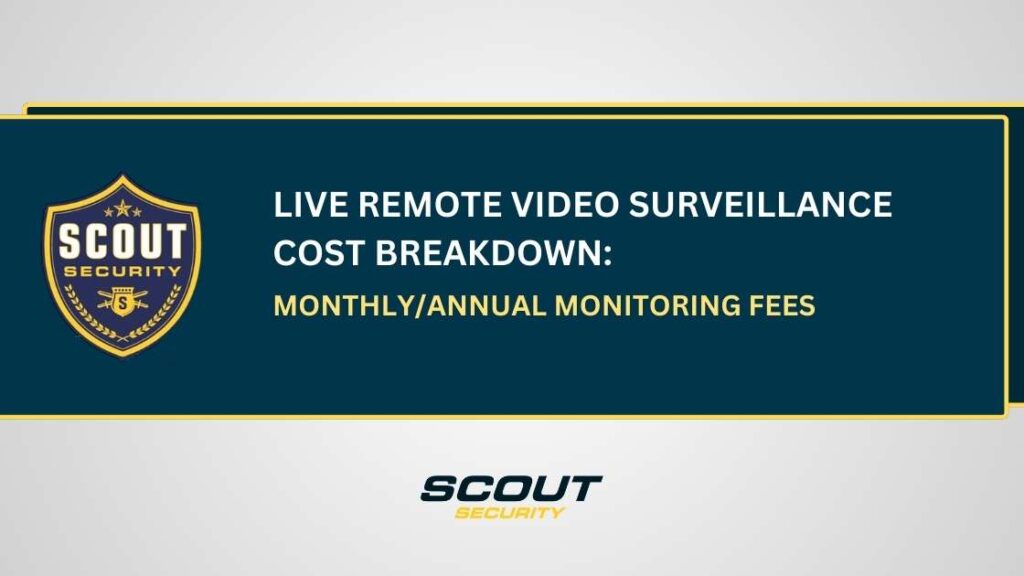
Live remote video surveillance involves ongoing monthly or annual fees for continuous monitoring and access to video footage.
The cost for these services varies based on several factors as discussed previously among others such as:
- Number of cameras
- Service level (e.g. real-time alerts, access to archived footage)
- Service type (self-monitoring vs. 24/7 professional monitoring)
- Advanced features
- Your location’s activity level
- Your service provider’s experience
- Your provider’s pricing structure (e.g. fixed monthly rate per camera or hourly charges)
Typically, monthly fees range from $30 to $150+ per camera. For areas with low activity, fees might be around $75+ per camera per month. In contrast, busier sites such as parking lots might incur charges of $8 to $10+ per hour.
Also Read: 23 Benefits of Outsourcing Video Monitoring and Surveillance Services
Other Important Things to Know About Live CCTV Monitoring Services
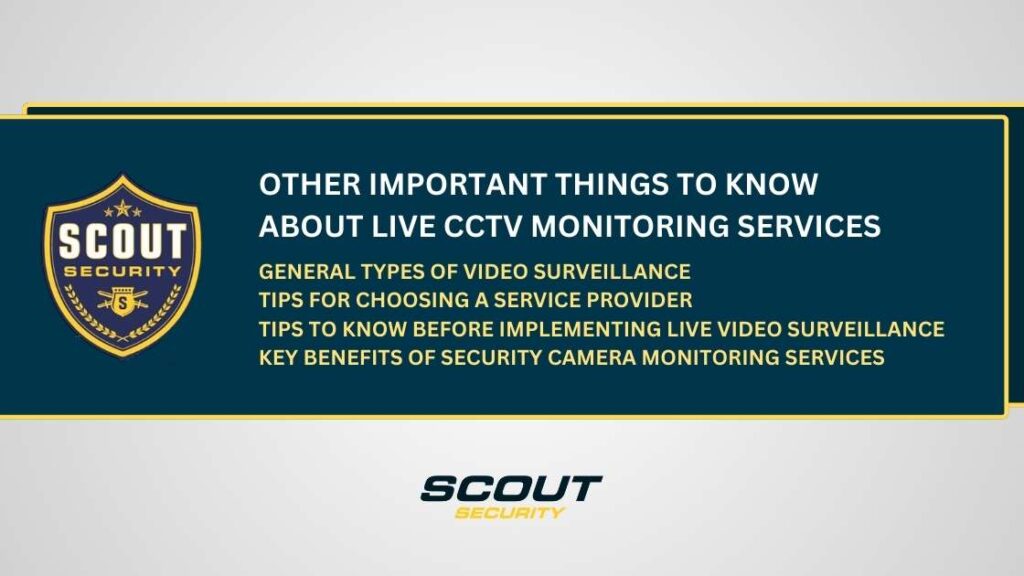
2 General Types of Video Surveillance
Video monitoring can either be self-monitored or professionally monitored. Below is an overview of each type:
| Self-Monitored Video | Professional Video Monitoring |
|---|---|
| – Cost-effective and suitable for low-risk small retail stores and offices – Business owners or managers directly oversee the video feeds – The main limitation is the availability of the owner because it requires continuous presence which is impractical – Problems regarding inadequate coverage and system vulnerability may occur due to a lack of professional guidance | – Third-party monitoring that provides professional expertise for guaranteed security through 24/7 surveillance and rapid incident response – The cost varies depending on your needs and the level of service provided – Costs more than self-monitoring but is worth the investment for larger businesses or high-risk areas |
Beyond mere recording, actively monitored systems through professional services enhance the effectiveness of your commercial security strategies.
Also Read: 19 Effective Retail Loss Prevention Strategies and Best Practices
8 Tips for Choosing a Reputable Commercial Remote Video Monitoring Service Provider
- Assess their experience and reputation.
- Make sure that they use advanced technology for secure, high-quality video feeds and effective monitoring.
- Find one that offers customization options to tailor services to your specific business requirements.
- Ask them about their pricing models to see if their services match your budget.
- Verify that they offer strong customer support. (Preferably available 24/7 to address any of your inquiries as soon as possible.)
- Request detailed quotes and conduct pricing comparisons among your top providers to find competitive rates without compromising quality.
- Be cautious of unusually low quotes which may indicate reduced reliability.
- Understand other related costs (i.e. ownership costs), including maintenance, warranties, and parts replacements, to avoid unexpected charges.
We highly recommend consulting a security professional to get video monitoring solutions that address the specific risks you are facing.
3 Helpful Tips to Know Before Implementing Live Video Surveillance for Your Business
- Consider expandability in your video surveillance setup (e.g. storage capacity) to accommodate future growth without requiring significant and expensive overhauls.
- Establish a realistic budget. Balance necessary costs against avoiding overspending on advanced features that you don’t really need.
- While not all businesses need commercial video surveillance, it is necessary if yours is vulnerable to crimes as it provides effective deterrence and swift response to mitigate costly damages.
Also Read: 25 Common Video Surveillance Mistakes to Avoid
10 Key Benefits of Security Camera Monitoring Services
- 24/7 Surveillance: They ensure continuous surveillance to safeguard your business around the clock including after business hours.
- Cost-Effectiveness: They are cheaper compared to on-site security guards. Thus, helping you cut costs related to hiring, training, and maintaining a physical security team.
- Deterrence of Criminal Activities: The presence of security cameras and the thought of being monitored deter potential intruders. This reduces theft, break-ins, vandalism, and unauthorized access.
- Rapid Response: Remote monitoring allows security personnel to quickly address suspicious activities and ensure prompt police response, potentially reducing the impact of security incidents.
- Flexibility and Scalability: You can customize and scale remote monitoring services according to the specific needs and size of your business.
- Technology Integration: CCTV systems can be integrated seamlessly with your existing security systems to streamline management and enhance the effectiveness of your overall security plan through a centralized control hub.
- Remote Accessibility: You can access live camera feeds and recorded footage from any location via the Internet.
- Operational Efficiency: You can focus more on your core business operations without the need to handle additional security tasks which improves overall productivity and resource allocation.
- Reduced Human Error: Automated features like motion detection and object recognition minimize the chances of human error and false alarms.
- Secure Data Storage: Recorded footage is securely stored in the cloud and can be accessed for potential legal, investigative, or insurance purposes.
Also Read:
- 21 Benefits of Remote Real-Time Video Monitoring for Businesses: A Comprehensive Guide
- 17 Benefits of Video Surveillance in Manufacturing Facilities
- 13 Benefits of Construction Site Surveillance and CCTV Monitoring
FAQs
Remote video monitoring involves the use of internet-based cameras (IP cameras) to stream live surveillance footage from an off-site location. This type of service allows professional operators at a central monitoring station to monitor your property 24/7.
It combines technology with human oversight to enhance security on your premises through features such as AI integration and real-time incident response.
The cost of professional video or CCTV monitoring services can vary significantly based on several factors like the following:
– Number of cameras
– Type and features of the cameras
– Size and complexity of your property
– Required monitoring hours
– Additional services or features (e.g. AI analytics, integration with your existing systems)
On average, costs can range from a few hundred dollars per month for simpler home systems to several thousand dollars per month for more complex commercial setups. (i.e. $3,000 to $7,000 and up to $15,000+.)
The cost to install CCTV cameras will depend on the system’s complexity, the number of cameras, and the features required. Basic installations can start from $100+ and can go up to $2,500+ for small to medium facilities.
For larger or more complex installations, such as industrial sites or warehouses, the installation fee can exceed $10,000. This does not include the cost of the equipment needed.
Make sure to get a detailed quote based on your specific needs from a professional installation service.
Consult With Scout Security for a Detailed Assessment Today
Get a free consultation with our experts now to get versatile video monitoring solutions tailored to your needs. With cutting-edge technology, a certified team of professionals, and years of experience in working with various industries in the Colorado Springs and Denver Metro areas, we guarantee your satisfaction with our services. Hire us now and get what you pay for!

